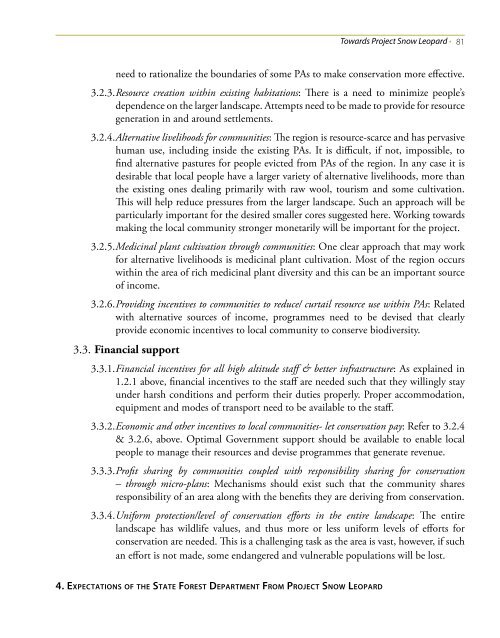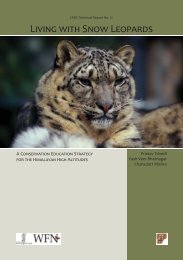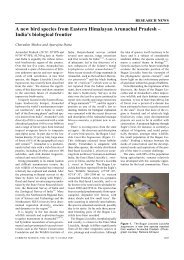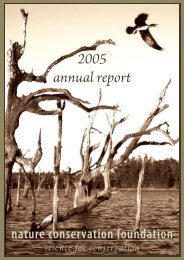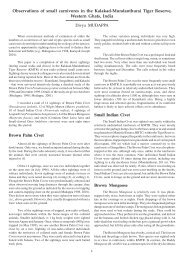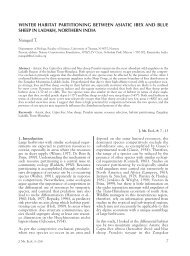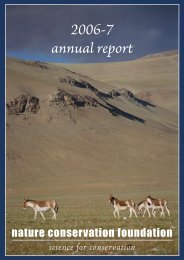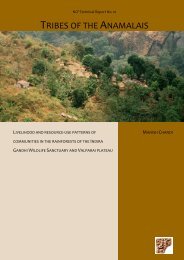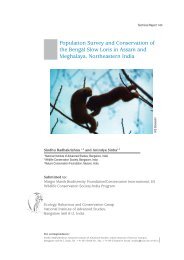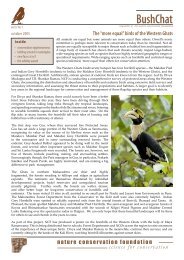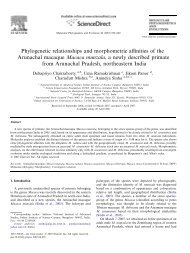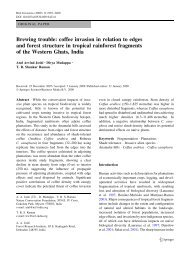towards project snow leopard - Nature Conservation Foundation
towards project snow leopard - Nature Conservation Foundation
towards project snow leopard - Nature Conservation Foundation
Create successful ePaper yourself
Turn your PDF publications into a flip-book with our unique Google optimized e-Paper software.
Towards Project Snow Leopard • 81<br />
need to rationalize the boundaries of some PAs to make conservation more effective.<br />
3.2.3. Resource creation within existing habitations: There is a need to minimize people’s<br />
dependence on the larger landscape. Attempts need to be made to provide for resource<br />
generation in and around settlements.<br />
3.2.4. Alternative livelihoods for communities: The region is resource-scarce and has pervasive<br />
human use, including inside the existing PAs. It is difficult, if not, impossible, to<br />
find alternative pastures for people evicted from PAs of the region. In any case it is<br />
desirable that local people have a larger variety of alternative livelihoods, more than<br />
the existing ones dealing primarily with raw wool, tourism and some cultivation.<br />
This will help reduce pressures from the larger landscape. Such an approach will be<br />
particularly important for the desired smaller cores suggested here. Working <strong>towards</strong><br />
making the local community stronger monetarily will be important for the <strong>project</strong>.<br />
3.2.5. Medicinal plant cultivation through communities: One clear approach that may work<br />
for alternative livelihoods is medicinal plant cultivation. Most of the region occurs<br />
within the area of rich medicinal plant diversity and this can be an important source<br />
of income.<br />
3.2.6. Providing incentives to communities to reduce/ curtail resource use within PAs: Related<br />
with alternative sources of income, programmes need to be devised that clearly<br />
provide economic incentives to local community to conserve biodiversity.<br />
3.3. Financial support<br />
3.3.1. Financial incentives for all high altitude staff & better infrastructure: As explained in<br />
1.2.1 above, financial incentives to the staff are needed such that they willingly stay<br />
under harsh conditions and perform their duties properly. Proper accommodation,<br />
equipment and modes of transport need to be available to the staff.<br />
3.3.2. Economic and other incentives to local communities- let conservation pay: Refer to 3.2.4<br />
& 3.2.6, above. Optimal Government support should be available to enable local<br />
people to manage their resources and devise programmes that generate revenue.<br />
3.3.3. Profit sharing by communities coupled with responsibility sharing for conservation<br />
– through micro-plans: Mechanisms should exist such that the community shares<br />
responsibility of an area along with the benefits they are deriving from conservation.<br />
3.3.4. Uniform protection/level of conservation efforts in the entire landscape: The entire<br />
landscape has wildlife values, and thus more or less uniform levels of efforts for<br />
conservation are needed. This is a challenging task as the area is vast, however, if such<br />
an effort is not made, some endangered and vulnerable populations will be lost.<br />
4. Expectations of the State Forest Department From Project Snow Leopard


